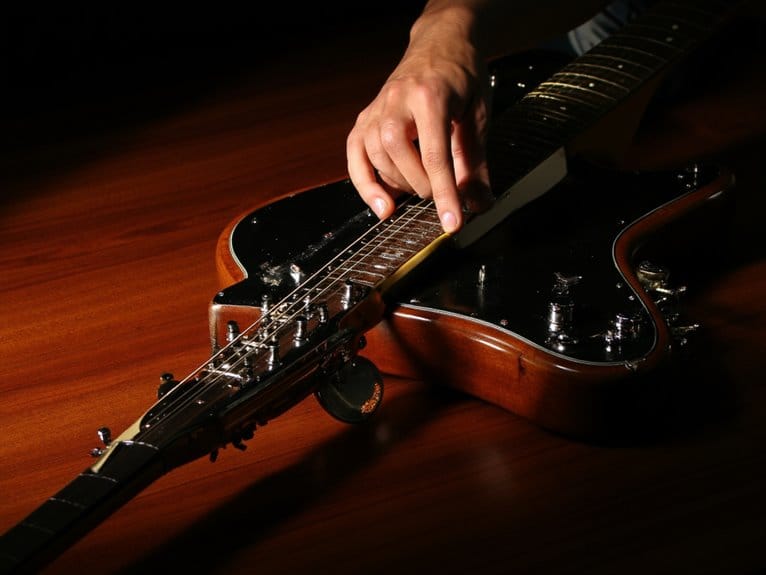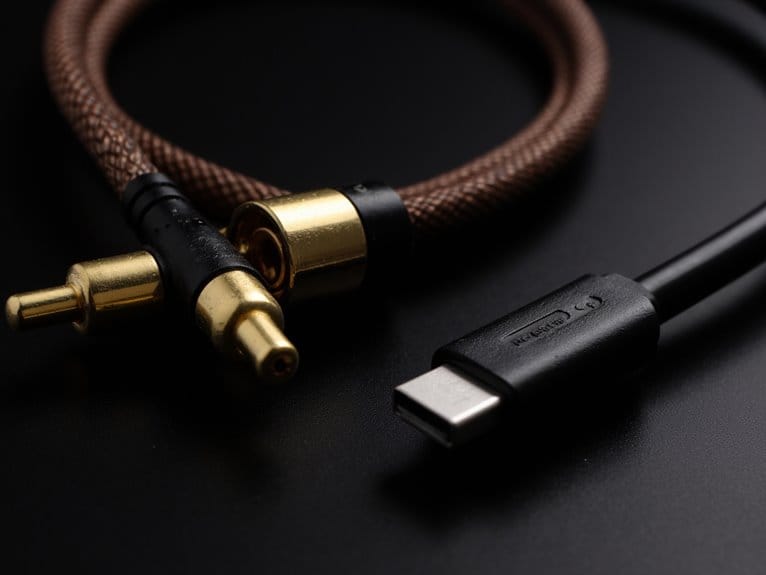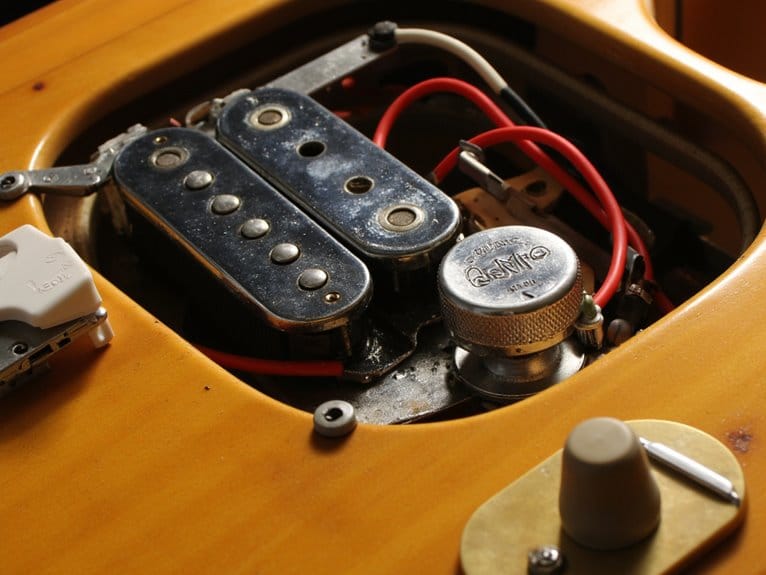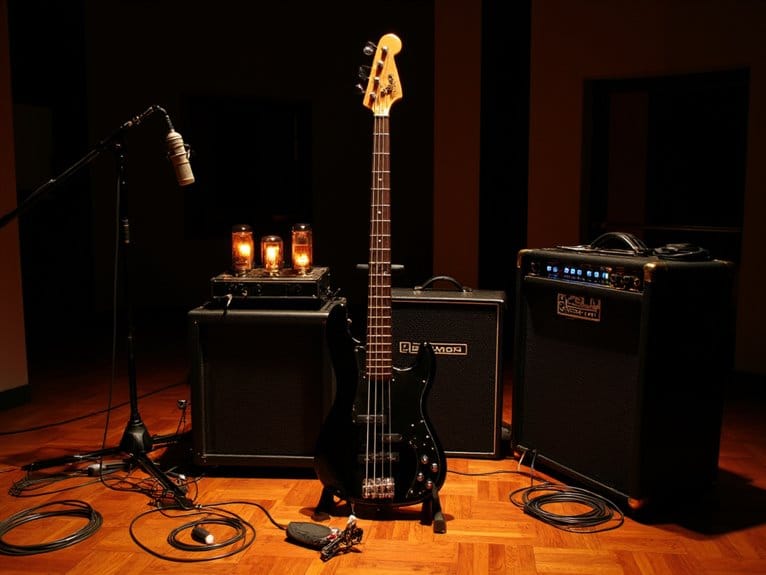Advanced Slide Techniques: Beyond Basic Open Tunings
You’ll elevate your slide playing by mastering harmonics through precise pressure control, targeting natural harmonic positions smoothly while using higher gain settings to enhance tonal texture. Double stops involve fretting one note while sliding another, creating rich harmonic intervals that demand clarity between both elements. Behind-slide fretting generates syncopated accents, while ghost movements add groove complexity through dynamic variations and strategic muted string control. Proper action height, slide angle adjustment, and thumb anchoring become critical for intonation control as techniques grow more sophisticated, and the real magic happens when you start combining these elements.
We are supported by our audience. When you purchase through links on our site, we may earn an affiliate commission, at no extra cost for you. Learn more.
Notable Insights
- Master slide harmonics by applying precise pressure control to create natural overtones while maintaining smooth approach to target positions.
- Develop double stop combinations by fretting one note while sliding another to create rich harmonic intervals and enhanced expressiveness.
- Integrate rhythmic techniques using behind-slide fretting for syncopated accents and ghost slide movements to add groove complexity.
- Optimize equipment setup with proper action height, slide angle adjustment, and thumb anchoring for superior intonation control.
- Enhance expression through modulation effects like flangers while maintaining clean articulation and utilizing solid wood construction for resonance.
Mastering Slide Harmonics and Double Stop Combinations
Two fundamental techniques separate amateur slide players from those who truly command the fretboard: slide harmonics and double stop combinations, both of which I’ve spent countless hours perfecting through trial and error.
These advanced techniques require precise pressure control when striking natural harmonics, like the 7th fret on your G string, then sliding smoothly into target positions without losing that ethereal tone.
Double stops become exponentially more expressive when you’re fretting one note normally while sliding another, creating rich harmonic intervals that sound impossibly complex.
Open tunings like E or D make this harmonic blending much more accessible, aligning intervals perfectly across strings.
You’ll need higher gain settings and careful muting to avoid unwanted noise, but the tonal texture you’ll achieve makes the effort worthwhile.
Rhythmic Integration and Behind-the-Slide Playing Methods
When most slide players focus exclusively on the melodic aspects of their technique, they’re missing half the equation-rhythm integration transforms slide guitar from a novelty into a legitimate rhythmic voice that can anchor or complement any musical arrangement.
| Technique | Rhythmic Impact |
|---|---|
| Behind-slide fretting | Creates syncopated accents |
| Ghost slide movements | Enhances groove complexity |
| Dynamic variations | Builds tension and release |
| Rhythmic space usage | Develops musical conversation |
| Muted string control | Maintains clarity and focus |
Behind-the-slide fretting opens incredible possibilities for rhythmic interplay, allowing you to fret notes with your fingers just behind the slide while maintaining steady groove patterns. This technique requires delicate balance-too much pressure mutes adjacent strings, while too little creates muddy articulation. Starting with the D, G, and B strings helps develop control before expanding your range, and practicing with a metronome guarantees your expressive phrasing stays locked to the beat. Adding modulation effects like flangers can enhance the rhythmic complexity by creating jet-plane sweeps and space sounds that emphasize the syncopated accents inherent in behind-the-slide techniques.
Equipment Setup and Left-Hand Control for Advanced Expression
Mastering the rhythmic elements I’ve covered means nothing if your equipment setup fights against your technique at every turn. I’ve learned this lesson through countless frustrating practice sessions where poor action height turned expressive slides into buzzing disasters.
Your slide angle becomes critical when you’ve raised your strings to medium-heavy gauge heights, requiring steady thumb anchoring behind the neck to maintain proper intonation control.
I’ve found that finger placements for muting neighboring strings work best when your action allows clean slide contact without excessive pressure, while a flatter fretboard radius lets you glide smoothly across multiple strings.
Dedicated slide setups with elevated string spacing transform your left-hand control from fighting the instrument to working with it. Consider that solid wood construction enhances resonance and sustain compared to laminated alternatives, making it particularly beneficial for slide guitar where sustained notes are essential for expressive playing.
On a final note
You’ve now explored the sophisticated domain of slide guitar techniques that separate weekend warriors from serious practitioners, and I’ll admit, these methods demand patience that I sometimes lack myself. While mastering harmonics, double stops, and behind-the-slide approaches requires consistent practice, you’ll discover these techniques reveal expressive possibilities that basic open tunings simply can’t provide, transforming your playing from competent to genuinely compelling through dedicated application.






